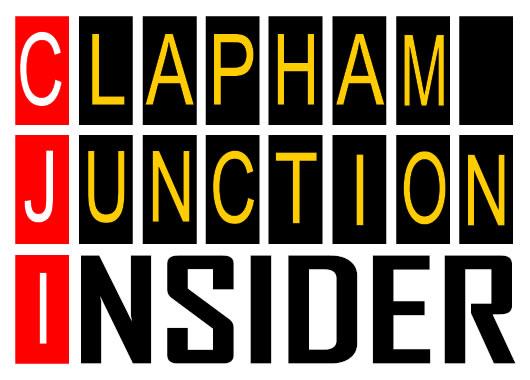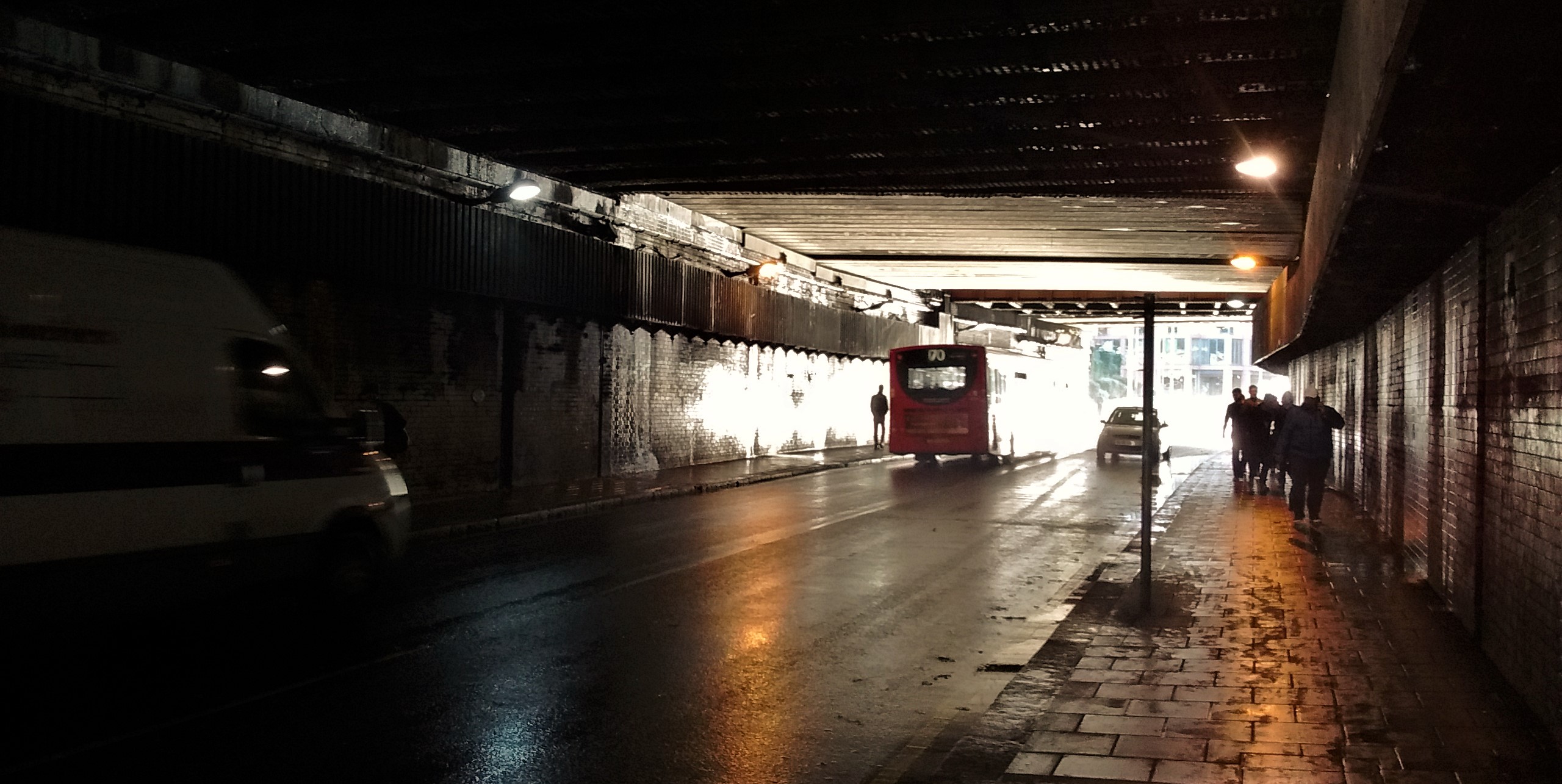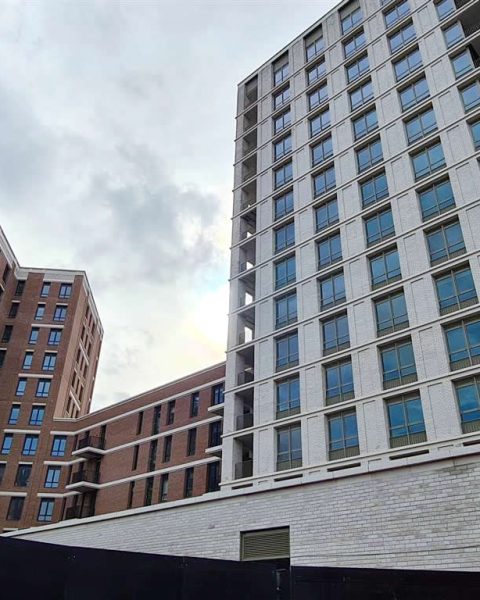The long-awaited revamp of Falcon Road railway bridge is now underway, with fresh blue paint already in place and new panels being installed along the underpass walls. The project aims to transform the gloomy gateway into a brighter, cleaner and more welcoming route through Clapham Junction.
It’s been a long time in the making. As we wrote way back in 2019, nobody likes the Falcon Road railway bridge. Dark, dirty, loud and with a mysterious tendency to be wet even when it’s not raining, the need to run the gauntlet of drips and pigeon poo discourages anyone who doesn’t live north of the tracks from venturing up the Falcon Road.
But like it or not, it’s unavoidable lowlight for many of us. It reinforces a long running north/south divide in Battersea, and prevents the businesses on the Falcon Road benefitting from being so close to Clapham Junction’s town centre. It’s also really just an unpleasant part of the day for anyone who needs to use it.
- Read our article: What can we do about Falcon Road’s horrible railway bridge?
Its run-down condition is not lost on Wandsworth Council. Back in the early 2000s the lighting was made brighter, the walls were deep cleaned, and some orange & pink feature lighting was added to a few of the girders above. For a while, the bridge did look better – but it wasn’t maintained, and sadly it wasn’t enough to turn the tide for Falcon Road.
To make matters worse, a major rail signalling upgrade then led to two huge cable ducts being installed above the pavement on each side of the road, creating even more space for pigeons and general dirt, and making the space feel even darker and more enclosed.

There has been a bit of a push in the last few years to deal with our shabby local underpasses. Thessaly Road in Nine Elms went first, with a design competition that attracted over 100 entries from ambitious emerging architects, followed by a major makeover (mainly funded by Nine Elms developers) that involved an explosion of colour.
It’s quite striking, it definitely changed the feel of the bridge which had previously been relatively clean but distinctly dark and gloomy, and it seems to have lasted well.

Earlsfield also saw a more “heritage” makeover – going for a Victorian railway green with the original station name restored. Both of these – which also involved some repairs to the bridges themselves – cost around £200k. The far end of the Wandsworth Road saw a much more DIY makeover, really just cleaning and painting it and adding some coloured lights.
Some of the more minor underpasses also saw some love: as reported on Lavender-Hill.uk the problematic underpass at Culvert Place has also seen new lights and some fairly rudimentary painting, as part of a bigger scheme to introduce a long-distance pedestrian phase through the tunnel.


Falcon Road probably sees as many pedestrians as these other bridges added together, and has been on the Wandsworth ‘to do’ list for ages – so we were pleased to see things finally get moving.
It started, as the more ambitious makeovers tend to, with a design competition, which saw seven proposals shortlisted. These were exhibited, and it was interesting to see both the wide range of approaches taken, and the variation in the extent to which the entries took account of the actual site.
- Read our article: Design competition launched to transform Falcon Bridge underpass in Clapham Junction
Some were led by very local teams who clearly knew the opportunities and headaches of the bridge in detail – like the need to deal with the big ugly cable ducts and the awkward scraps of land either side – while others were clearly a bit more conceptual.
There was also a vote on which should be taken forward.
The vote was only advisory: the final decision was made by an expert panel – as in choosing the design team for the project they also needed to take account of various less obvious factors like cost, practicality and technical deliverability.
- Read our article: Falcon Bridge: Design Shortlist Revealed – Now It’s Time to Vote!

The Panel chose Beyond the Bridge, presented by design team of GPAD (a Hackney-based architecture & interior design practice), POoR Collective, MRG Studio, Sutton Vane Associates, Cundall, and MDA Consulting – the headline image from their design is shown below.

Proposed features included a Memories of Wandsworth wall of local stories and artwork (mainly on panels attached in front of the existing glazed wall bricks), new seating areas at either end of the bridge with pollinator-friendly plants, smart lighting all the way through that can change colour for different occasions and events, and sound-absorbing panels to reduce noise under the bridge.

- Read our article: Winner for Falcon Bridge makeover competition revealed
Now a ‘competition winning’ design tends not to translate directly to a workable real-world build, especially in a damp and messy working environment with loads of constraints – like the need for Network Rail to get maintenance access, the need to make something that will stay clean, and the need to remain within a realistic budget!
So more work then took place to refine the design and prepare it for actual construction.

This included a series of co-design workshops that explored how the designs could reflect the unique identity, culture and history of Clapham Junction, including how locals perceive the area, and the significance of Falcon Road Bridge and its surrounding areas to the community, and what residents want their neighbourhood to be like in the future.
The workshops, and a series of drop-in events at Lavender Hill library, Clapham Junction and in and around the bridge itself, also explored more practical issues – with an opportunity to explore the designs and highlight issues with the existing underpass.
The feedback was exactly what would probably have been expected: unsurprisingly was good feedback on the approach of having way more lighting and greenery, and on having a cleaner, safer, and generally nicer walkway, as well as for designs reflecting local heritage and diversity.
Pigeons, on the other hand, unsurprisingly dominated the negative feedback – as did the eternal dampness of the area and scope for being splashed by vehicles, and some wise thoughts about the need for long term maintenance and cleaning, and for the planting areas to be looked after.
We now have the more detailed plans – which are reasonably clever. Many of the higher level panels which have lighting and railway signal cables running behind them will have hinges so that Network Rail can still get to the cables behind them without destroying the whole setup.

Given that there’s no way of fully waterproofing a 150-year-old railway structure that has a load of wet earth behind it, the panels have a space behind them to allow for drips and they don’t go right to the ground – so that they can allow any leaking water to still escape from the structure. The existing wall above and below the panels will be painted a dark colour to avoid any muck being too visible.

A lot of thought has gone in to the lighting – where the existing street lights remain in place, but new colour-changing lights are also added that face both upwards to light the ceiling, and down below the big cable ducts to light the pavement.
These will need to be of a tough enough design to withstand the wet and somewhat mucky environment of a railway underpass – but are likely to make a big difference to the overall feel of Falcon Bridge.

The ends of the bridge are currently home to rather scruffy patches of wasteland and unofficial advertising hoardings. These will be replaced with planting and seating more or less following the design in the original competition.

The pavement on the station entrance side south of the bridge will be partly covered by new seating and planting, while the curious alcove between Lidl and the bridge will also be planted.
A similar approach is being taken at the other end of the bridge, but only on the Banana Park side where there’s enough space.

The bridge will also be properly named – with an illuminated Falcon Bridge sign likely to be added at each end.

These changes needed planning permission – so Wandsworth submitted a proposal for “Alterations including installation of panelling system to tunnel walls, illuminated signage on north and south elevations of bridge, highway and creative lighting and landscaping and seating on southern side of the tunnel“.
It’ didn’t prove particularly controversial; the only comment at the time of writing is from the Battersea Society who support the plans – in particular the work to divert rain away from the pavements, to use panels to create a cleaner and dryer surface on the walls, and to tidy up the green spaces at each end of the tunnel – while expressing concerns on whether some aspects of the proposal will be easy to maintain to an adequate standard, and mild surprise that what is actually going to go on the panels remains a mystery at this stage.


Work has, in the meantime, already got going – starting with a pressure wash and complete repaint of the main bridge structure.

It’s all becoming very blue – the concrete bridge sections are being painted directly, while the iron and steel parts have an undercoat followed by the blue.

We understand that the metal parts were found to be in a surprisingly good condition once it got a pressure wash, with the original layers of paint not needing further sandblasting or removal – so this part of the project has advanced quickly.

The photo above shows the pink sections that were painted in the previous effort to improve the underpass in the mid-2000s (which was accompanied by localised coloured lighting, until it got removed to make way for Network Rail’s new signal cables) as well as the new grey undercoat on the steel sections, and the final blue paint on the concrete sections. Some sections were also previously painted orange as visible in the photo below.

Both ends of the bridge have already seen a repaint, which has somewhat improved their appearance (and made them a lot cleaner).
Like a lot of Network Rail’s bridges, these are a prime target for graffiti – we’re hoping that some sort of grill is also installed inside the railing, to make it harder for taggers to reach through or over the parapets and vandalise the newly painted surfaces. Because with schemes like this one, what is actually one sometimes matters less than how it is maintained in the future.
The design needs to take quite careful account of how the design can resist future graffiti, pigeons, dirt, leaks and general muck without needing expensive follow up work, and the Council needs to have a cleaning process that keeps a reasonable eye on it. Network Rail – who own the bridge – apparently declined to do any repair work on the leaky tunnel roof, meaning there’s obviously a risk that all the planned improvements quickly become dirty and spoil the impact of the new lighting.
The issue of pigeons on the ledges remains a bit TBC – hopefully something can be fitted that prevents them perching all day above the pavement.

The walls either side of the underpass are currently being covered over with galvanised steel battens, which will hold the planned panels right along both sides of the bridge.
These will be made of vitreous enamel – a super strong material produced by the same people who make signs for TfL, so we can be fairly confident it will be tough and long-lasting (the planning application includes details of how graffiti is cleaned off this type of panel).

This still has a while to run, and while no amount of lighting and decoration can fully magic away the somewhat unpleasant nature of this underpass, this project is very much good news and is finally progress on something that has been a lowlight of the Clapham Junction town centre for decades.
Wandsworth have taken a fairly imaginative approach to developing designs and run a surprisingly large public engagement programme on the details, and seem to be throwing a reasonably large budget at it – fingers crossed the end result lives up to the fairly high expectations.
This article was originally published on lavender-hill.uk.
Lavender-hill.uk is a community site covering retail, planning and development and local business issues, and sometimes posts like this one on transport and the environment – all centered on the Lavender Hill area in Battersea.

















